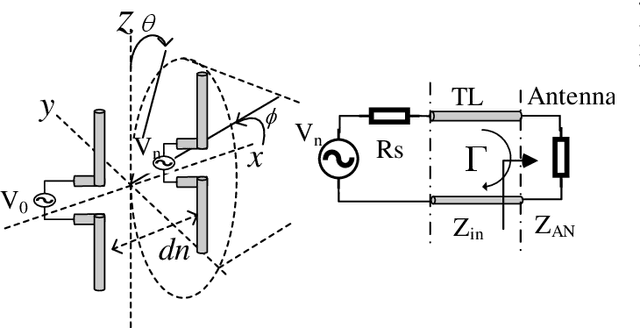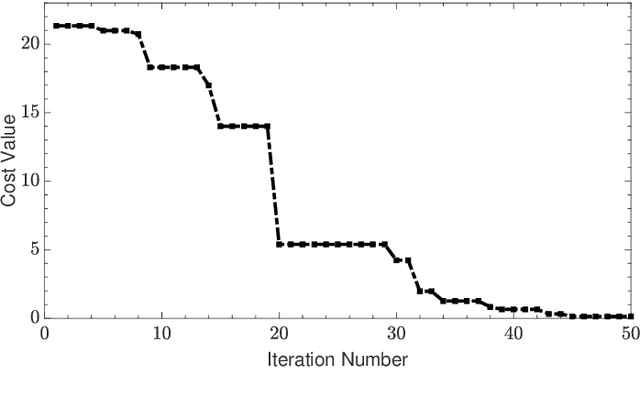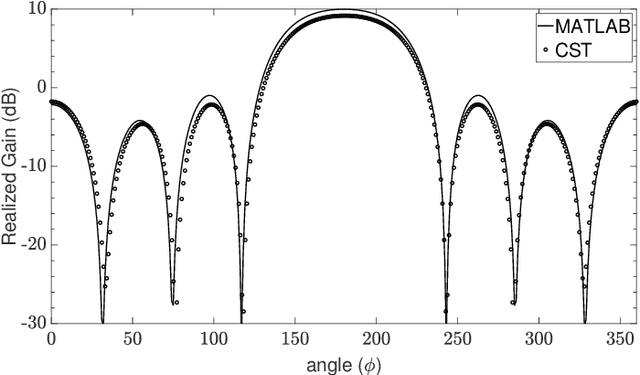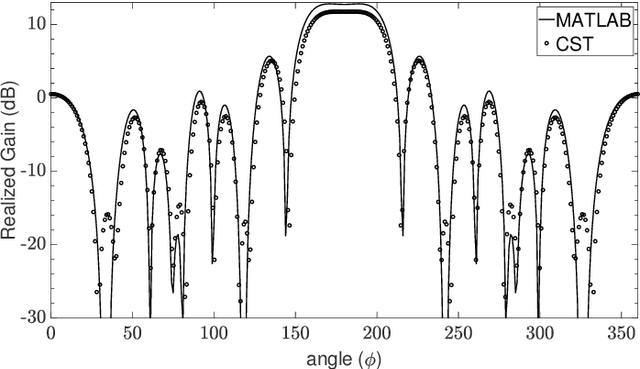Okan Yurduseven
Adversarial Learning-Based Radio Map Reconstruction for Fingerprinting Localization
Nov 18, 2025Abstract:This letter presents a feature-guided adversarial framework, namely ComGAN, which is designed to reconstruct an incomplete fingerprint database by inferring missing received signal strength (RSS) values at unmeasured reference points (RPs). An auxiliary subnetwork is integrated into a conditional generative adversarial network (cGAN) to enable spatial feature learning. An optimization method is then developed to refine the RSS predictions by aggregating multiple prediction sets, achieving an improved localization performance. Experimental results demonstrate that the proposed scheme achieves a root mean squared error (RMSE) comparable to the ground-truth measurements while outperforming state-of-the-art reconstruction methods. When the reconstructed fingerprint is combined with measured data for training, the fingerprinting localization achieves accuracy comparable to models trained on fully measured datasets.
Integrated Image Reconstruction and Target Recognition based on Deep Learning Technique
May 07, 2025Abstract:Computational microwave imaging (CMI) has gained attention as an alternative technique for conventional microwave imaging techniques, addressing their limitations such as hardware-intensive physical layer and slow data collection acquisition speed to name a few. Despite these advantages, CMI still encounters notable computational bottlenecks, especially during the image reconstruction stage. In this setting, both image recovery and object classification present significant processing demands. To address these challenges, our previous work introduced ClassiGAN, which is a generative deep learning model designed to simultaneously reconstruct images and classify targets using only back-scattered signals. In this study, we build upon that framework by incorporating attention gate modules into ClassiGAN. These modules are intended to refine feature extraction and improve the identification of relevant information. By dynamically focusing on important features and suppressing irrelevant ones, the attention mechanism enhances the overall model performance. The proposed architecture, named Att-ClassiGAN, significantly reduces the reconstruction time compared to traditional CMI approaches. Furthermore, it outperforms current advanced methods, delivering improved Normalized Mean Squared Error (NMSE), higher Structural Similarity Index (SSIM), and better classification outcomes for the reconstructed targets.
Holographic Metasurfaces Enabling Wave Computing for 6G: Status Overview, Challenges, and Future Research Trends
Jan 09, 2025



Abstract:Recent advancements in wave computing using metasurfaces are poised to transform wireless communications by enabling high-speed, energy-efficient, and highly parallelized signal processing. These capabilities are essential to meet the ultra-high data rates of up to 1 terabit per second and minimal latency as low as 1 millisecond required by next-generation wireless networks. Diverging from traditional digital processing, wave computing adopts continuous analog signals to foster innovative functions such as over-the-air computation, integrated sensing and communications, computational electromagnetic imaging, and physical-layer security. This article explores the potential of reconfigurable multi-functional metasurfaces in wave computing, emphasizing their pivotal role in facilitating seamless communications and addressing the escalating computational demands for sixth generation (6G) networks. As artificial intelligence has become one of the most prominent and rapidly advancing fields of research over the last decade, we also introduce a wave-domain-based machine learning approach aimed at achieving power-efficient, fast training and computation. Future research directions are discussed, underscoring how metasurface-based systems can merge computation with communication to innovate components of 6G networks, thus creating smarter, faster, and more adaptable wireless infrastructures.
Differential Evolution-Based End-Fire Realized Gain Optimization of Active and Parasitic Arrays
Oct 21, 2024



Abstract:We propose a novel approach for boosting the realized gain in enhanced directivity arrays with both active and parasitic dipoles as radiating elements. The optimization process involves two main objectives: maximizing the end-fire gain and minimizing the reflection coefficient to ensure high realized gain. In the first step, the current excitation vector of the fully driven array is selected to maximize the end-fire gain. Then, all but one of the dipoles are reactively loaded according to their input impedance. Following that, the optimization focuses on the inter-element distance, computing the one that offers a favorable balance between the gain and the total efficiency. This multi-objective optimization leverages the differential evolution (DE) algorithm and utilizes a simple wire dipole as the unit element. Full-wave simulations further confirm the accuracy of our theoretical results. Our two- and three-element parasitic arrays achieve realized gain comparable to state-of-the-art designs, without relying on intricate unit elements or resource-intensive simulations. Moreover, our four- and five-element parasitic arrays deliver the highest realized gain values reported in the literature. The simplicity of our approach is validated by significant time savings, with theoretical models completing optimizations much faster than full-wave simulations. Additionally, a sensitivity analysis confirms the robustness of the proposed optimization algorithm, demonstrating that the optimized design parameters remain effective even under small deviations in loads and element positions. Finally, the proposed parasitic arrays are well-suited for base station antennas due to their compact design, reduced power consumption, and simplified hardware requirements, making them ideal for modern communication systems.
Near-Field Localization with Antenna Arrays in the Presence of Direction-Dependent Mutual Coupling
Aug 13, 2024



Abstract:Localizing near-field sources considering practical arrays is a recent challenging topic for next generation wireless communication systems. Practical antenna array apertures with closely spaced elements exhibit direction-dependent mutual coupling (MC), which can significantly degrade the performance localization techniques. A conventional method for near-field localization in the presence of MC is the three-dimensional (3D) multiple signal classification technique, which, however, suffers from extremely high computational complexity. Recently, two-dimensional (2D) search alternatives have been presented, exhibiting increased complexity still for direction-dependent MC scenarios. In this paper, we devise a low complexity one-dimensional (1D) iterative method based on an oblique projection operator (IMOP) that estimates direction-dependent MC and the locations of multiple near-field sources. The proposed method first estimates the initial direction of arrival (DOA) and MC using the approximate wavefront model, and then, estimates the initial range of one near-field source using the exact wavefront model. Afterwards, at each iteration, the oblique projection operator is used to isolate components associated with one source from those of other sources. The DOA and range of this one source are estimated using the exact wavefront model and 1D searches. Finally, the direction-dependent MC is estimated for each pair of the estimated DOA and range. The performance of the proposed near-field localization approach is comprehensively investigated and verified using both a full-wave electromagnetic solver and synthetic simulations. It is showcased that our IMOP scheme performs almost similarly to a state-of-the-art approach but with a 42 times less computational complexity.
Near-Field Localization with an Exact Propagation Model in Presence of Mutual Coupling
Jul 28, 2024


Abstract:Localizing near-field sources considering practical arrays is important in wireless communications. Array-based apertures exhibit mutual coupling between the array elements, which can significantly degrade the performance of the localization method. In this paper, we propose two methods to localize near-field sources by direction of arrival (DOA) and range estimations in the presence of mutual coupling. The first method utilizes a two-dimensional search to estimate DOA and the range of the source. Therefore, it suffers from a high computational load. The second method reduces the two-dimensional search to one-dimensional, thus decreasing the computational complexity while offering similar DOA and range estimation performance. Besides, our second method reduces computational time by over 50% compared to the multiple signal classification (MUSIC) algorithm.
Optimization of Super-Directive Linear Arrays with Differential Evolution for High Realized Gain
Feb 10, 2024



Abstract:Due to the low impedance and high feeding currents, it is naturally challenging to design super-directive antenna arrays that perfectly match the feed line, and this becomes almost impossible as the number of elements increases. In this paper, we assert that it is crucial to consider the trade-off between directivity and overall efficiency (to achieve high realized gain) before employing super-directive arrays in real-world applications. Given this trade-off (high directivity and low mismatch for high realized gain), a 4-element dipole array (unit array) is optimized using the differential evolution (DE) algorithm. Then, the performance of the unit array in subarray configuration scenarios is analyzed. Finally, the obtained parameters are verified using the CST full-wave simulation software. The results clearly indicate that the proposed unit array is a strong candidate for dense array applications, particularly in the context of massive multiple-input multiple-output (MIMO), thanks to its notable high gain and efficiency.
Super-Directive Antenna Arrays: How Many Elements Do We Need?
Jan 17, 2024Abstract:Super-directive antenna arrays have faced challenges in achieving high realized gains ever since their introduction in the academic literature. The primary challenges are high impedance mismatches and resistive losses, which become increasingly more dominant as the number of elements increases. Consequently, a critical limitation arises in determining the maximum number of elements that should be utilized to achieve super-directivity, particularly within dense array configurations. This paper addresses precisely this issue through an optimization study to design a super-directive antenna array with a maximum number of elements. An iterative approach is employed to increase the array of elements while sustaining a satisfactory realized gain using the differential evolution (DE) algorithm. Thus, it is observed that super-directivity can be obtained in an array with a maximum of five elements. Our results indicate that the obtained unit array has a $67.20\%$ higher realized gain than a uniform linear array with conventional excitation. For these reasons, these results make the proposed architecture a strong candidate for applications that require densely packed arrays, particularly in the context of massive multiple-input multiple-output (MIMO).
Graph Attention Network Based Single-Pixel Compressive Direction of Arrival Estimation
Sep 12, 2021



Abstract:In this paper, we present a single-pixel compressive direction of arrival (DoA) estimation technique leveraging a graph attention network (GAT) based deep-learning framework. The physical layer compression is achieved using a coded-aperture technique, probing the spectrum of far-field sources incident on the aperture using a set of spatio-temporally incoherent modes. This information is then encoded and compressed into the channel of the coded-aperture. The coded-aperture based receiver exhibits a single-channel, replacing the conventional multichannel raster scan based solutions for DoA estimation. The GAT network enables the compressive DoA estimation framework to learn the DoA information directly from the measurements acquired using the coded-aperture. This step eliminates the need for an additional reconstruction step and significantly simplifies the processing layer to obtain the DoA estimate. We show that the presented GAT integrated single-pixel radar framework can retrieve high fidelity DoA information even under relatively low signal-to-noise ratio (SNR) levels.
 Add to Chrome
Add to Chrome Add to Firefox
Add to Firefox Add to Edge
Add to Edge